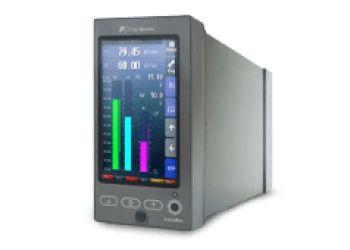
Multifunction controller - PSC100 series - 2 loops
ref : PSC100From
2928,00 € Request a quoteThe issue of energy efficiency is crucial in the metalworking, steel and casting industries, if they want to succeed in their energy transition. Several appropriate measurement and analysis instruments (gas analysis, pressure measurement, flow measurement, temperature measurement, level measurement) can be used to make energy savings, reduce costs and lower the carbon footprint. Saving and reducing the energy consumption in each process is in the hands of all industrial companies.

Fuji Electric measuring instruments support professionals in the metal working, steel and casting industries during each phase of their manufacturing process in order to:
Metal quality control
Compliance with current standards
Energy efficiency
Personnel and plant safety
For efficient operation of a blast furnace, particle size of iron ore (used as steel raw material) should be made uniform. In sintering furnaces, raw materials (pulverized ore, limestone and water) are ignited by burner. Then they are baked to be formed into a plate and pulverized again. Finally they are sieved to become particles of the same size.
In this process, it is necessary to control temperature inside the furnace and air-fuel ratio and to monitor harmful emission.

Coke oven is an oven for the conversion of coal into coke by heating coal in the absence of air so to expel the volatile ingredients. Coal is cooked at temperatures from 1200°C to 1300°C within the airless coke oven. The coke oven is a crucial part of the coke-making process.
To optimize this process combustion control and exhaust gas monitoring are essential.

Coke Dry Quenching (CDQ) is a heat recovery system to quench red hot coke from a coke oven to a temperature appropriate for transportation. It is an energy saving system in which, during quenching process, sensible heat of the red hot coke is recovered and utilized for power generation or as steam.
During quenching process gas monitoring is necessary to prevent explosion caused by CO vaporized from red hot coke H2.

The Blast Furnace is a heat based machine using solely for the creation of Steel. Iron ore and coke are heated at approx. 1200°C to produce iron pig. In the blast furnace carbon (coke) takes oxygen from iron oxide (iron ore) and reduces it into iron. During this process heat, CO and CO2 are produced.
For the best blast furnace efficiency, quality control of pig iron, furnace combustion control and harmful exhaust gas monitoring are required.

Pig iron produced in a blast furnace contains various impurities in addition to carbon. It is treated in the decarburizing furnace to improve its purity. There is no need for supplying heat because oxidation heat is generated when oxygen is blown into a converter. Flue gas produced in a converter furnace (converter gas) is reused for power generation or heating in rolling process.
To manage the quality of molten steel it is necessary to monitor the decarburizing process while controlling the blowing amount of oxygen.

Vacuum degasser is installed in many blast furnaces and steel manufacturers to eliminate H2 and inclusions and to enhance productivity.
Degassing is a secondary metallurgy process. A vacuum chamber which has two immersion tubes is positioned inside a ladle. Argon is fed into one of the immersion tubes to draw molten steel into the chamber and to remove H2 02 N2 and non-metallic inclusion.

The molten steel decarburized in converter furnace is injected to a ladle and transported to continuous casting equipment to be molded. Argon gas is filled in the ladle to prevent molten steel from oxidization.
Oxygen monitoring is necessary to ensure an oxygen-free condition inside the ladle.

Slabs are heated in the reheat furnace (800°C to 1000°C) so that they become soft enough to roll.
Optimum combustion control is required for reducing harmful emission and for energy saving.

Rolling is a process to roll out the heat slabs and coil them. Rolling mills roll out slabs heated at 1000°C. Slabs thickness pass from is 250 mm to 1 mm after the rolling mill process. At the end a rolled slab becomes a trip of several kilometres and coiled just like a roll of toilet paper.

During these processes gas components related to Carbon Potential (CO2, CO, CH4, NH3, H2 ou O2) must be monitored and controlled.


Find out how gas analysers help reduce pollutants and promote the development of clean energies for a sustainable environment.
June 09, 2024